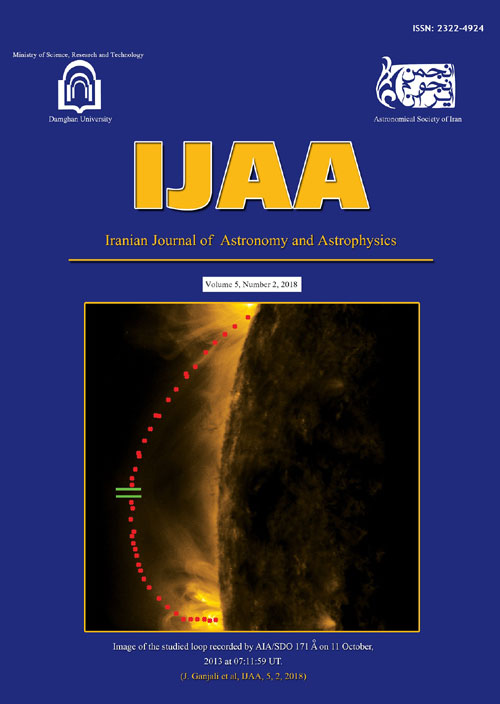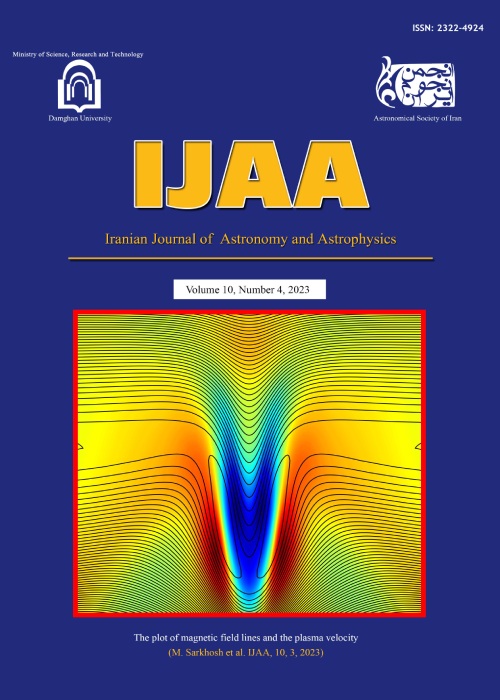فهرست مطالب

Iranian Journal of Astronomy and Astrophysic
Volume:7 Issue: 1, Spring 2020
- تاریخ انتشار: 1400/05/05
- تعداد عناوین: 6
-
-
صفحات 1-10
بهبود بخشیدن به دقت آزمایشات مربوط به گرانی سنجی نقش مهمی را در آشکارسازی امواج گرانشی بازی می کند. اولین نمایش کاربرد کاواکهای اپتومکانیکی کوانتومی در گرانی سنجی اخیرا گزارش شده است. این آزمایش با به کارگیری یک نانو کره در دمای بسیار پایین انجام شده است، که نقش یک نوسانگر کوانتومی مکانیکی را بازی می کند. به دنبال این آزمایش، پیشنهاده جدیدی برای به خدمت گرفتن کاواک های اپتومکانیکی برای سنجش شتاب گرانشی ارایه شده است. یک سامانه معمول برای گرانی سنجی عموما شامل دو کاواک اپتومکانیکی است که با همدیگر درگیر شده اند. در این گونه سامانه ها، آینه های کاواک نقش نوسانگرهای مکانیکی را بازی می کنند. در این مقاله سامانه ای متشکل از دو سلول هر کدام یک کاواک اپتومکانیکی را مطالعه می کنیم، که با هم برهمکنش دارند. شرایط بهینه بر حسب پارامترهای سامانه، شامل ضریب برهمکنش فوتون-فوتون، فوتون-فونون و توان میدان الکترومغناطیسی ورودی به هر کاواک و همچنین مد نوسانی بخش مکانیکی را به روش عددی محاسبه می نماییم. نشان خواهیم داد که دو رفتار متفاوت برای دینامیک درهمتنیدگی بسته به مقادیر انتخاب شده برای پارامترهای سامنه وجود دارد.
-
صفحات 11-18شراره های خورشیدی از جمله پدیده های بزرگ مقیاس خورشیدی هستند که تاثیر شگرفی بر آب وهوای زمین دارند. با استفاده از سری زمانی داده های شراره ی خورشیدی از اول ژانویه 2006 تا 21 ژولای 2016 ، شبکه ی پیچیده برای پیش بینی شراره های خورشیدی را توسعه می دهیم. در این مطالعه، یک الگوی ترکیبی برای ساخت شبکه ی پیچیده ی شراره های خورشیدی را اریه می دهیم. با استفاده از شبکه ی پیچیده ی ساخته شده حاضر، قانون اموری به-عنوان یک خاصیت جهان شمول برای زنجیره ی پس شراره ها بازیابی می شود. بسامد پس شراره های خورشیدی با زمان به صورت توانی کاهش پیدا می کند. تجزیه وتحلیل آماری از کاتالوگ های رویدادهای شراره ای اشاره می کند که یک وابستگی توانی وقوع هر دو پیش شراره وپس شراره ی متناظر با یک شراره اصلی را مشخص می کند. الگوی ترکیبی قانون اموری را برای فرایندهای پیش شراره-پس شراره همبسته بایک رویداد اصلی را بازسازی می کند.
-
صفحات 19-24آرایه رادیویی دانشگاه سمنان (SURA) با چهار آنتن LPDA در پشت بام دانشکده فیزیک دانشگاه سمنان در حال ثبت رویدادهای پرتو کیهانی می باشد. به منظور افزایش کارایی این آرایه قرار است در آینده نزدیک سه آشکارساز سوسوزن بعنوان راه انداز خارجی به این مجموعه اضافه شود. در کار حاضر با استفاده از کد شبیه سازی CORSIKA برای پرتو اولیه پروتون در محدوده ی انرژی TeV100- PeV100و در زوایای تابش مختلف انجام شده است. برای این مجموعه شبیه سازی جهت ورود پرتو اولیه و خطا و موقعیت هسته محاسبه شده است و تاثیر فاصله آشکارسازها روی بازسازی جهت ورود پرتو اولیه بررسی شده است. از آنجایی که ساختار بهمن (ضخامت و انحنا دیسک) بر روی اندازه گیری جهت ورود تاثیر می گذارد، تفکیک زاویه ای بر حسب فاصله از هسته نیز مورد مطالعه قرار گرفته است. بعلاوه مطالعه هسته های هادرونیک EAS ابزاری سودمند برای بررسی مدلهای اندرکنش هادرونی است. نشان داده ایم خطا با افزایش زاویه سرسویی و افزایش فاصله از هسته بهمن، افزایش و با افزایش انرژی کاهش می یابد.
-
صفحات 25-31
هدف از این مطالعه بررسی لغزش فضایی - زمانی زمین لرزه 27 آگوست 2010 کوه زر با بزرگی گشتاوری 5.8 می باشد. با استفاده از روش برگردان لغزش خطی مقید، میزان جابجایی در صفحه گسل را محاسبه کردیم. توزیع لغزش فضایی این زمین لرزه در کار قبلی توسط بازرگان و همکاران (2018) با دلتا مساوی با 0.1 ثانیه (دلتا نرخ نمونه برداری می باشد یعنی 10 نمونه در1 ثانیه) تخمین زده شده است. ما در این کار لغزش را با دلتای 0.2 ثانیه ، برای بهتر کردن نتایج دوباره بررسی کردیم. برای تعیین اندازه بهینه پارامترهایی مانند سرعت گسیختگی و زمان برخاست، تعداد بسیار زیادی اجرای برگردان صورت گرفته است. در این پژوهش، سرعت گسیختگی 2.55 کیلومتر بر ثانیه و زمان برخاست 1.8 ثانیه را به کار برده ایم. به طور کلی سرعت گسیختگی به غیر از گسلش فراصوتی که در آن اندازه ای برابر با سرعت موج P دارد، برابر 80 الی 90 درصد سرعت برشی است. گزینش اندازه سرعت گسیختگی بر اندازه لغزش و مساحت آن تاثیر بسزایی دارد. از آنجا که نتایج برگردان لغزش می تواند سطح بالایی ازعدم قطعیت داشته باشد، ما سعی کردیم نتایج قبلی را با استفاده از دلتای متفاوت و اضافه کردن تحول زمانی به محاسبات توسعه دهیم. توزیع لغزش فضایی - زمانی این رویداد متناسب با 48 درصد داده با بیشینه لغزش 8 سانتی متربدست آمد.
-
Pages 1-10
Improvement of precision in gravimetry is an important problem in detecting the gravitational waves. In The first demonstration of using quantum optomechanical cavity in gravimetry has recently been reported. This experiment has been done by employing a cooled levitated nano-sphere as a mechanical oscillator in its ground state coupled to a cavity electrodynamics. Following this experiment, in a recent proposal, a quantum optomechanical system has been used for measuring of gravitational acceleration. A generic setup for gravimetry purposes, containing two couples optomechanical cavities, where mirrors play the role of oscillating parts. We study such quantum mechanical system, by investigation the dynamics of entanglement between different parts of two coupled cavity optomechanical cells. For such setup, optimal conditions for predesignated entanglement behavior, based on some important parameters of the system, like photon-photon and photon-phonon couplings, electromagnetic field strength and mechanical mode of moving mirrors are analyzed numerically. We show that there exist two different behaviors for entanglement according to selected values for the system parameters.
Keywords: Optomechanical cavity, Linear entropy, Mandel’s parameter -
Pages 11-18Solar flares are large-scale phenomena that have a significant effect on the Earth’s climate. Using the solar flare time series from January 1, 2006 to July 21, 2016, we develop a complex network for predicting solar flares. In the work, hybrid model is employed to construct complex network. In addition to the position of the flares and their occurrence times, the energy of events based on the Telesca-lovallo model is also used to develop solar flare network. Using constructed complex network, the Omori’s law for fore flare and after flares associated with a main flare are retrieved. The frequency of occurrence of solar flares decreases over time as a power law. Statistical analysis of flaring events catalogues indicates that a power-law dependence characterizes the occurrence of both fore flares and after flares corresponding to a main flare. The hybrid model reconstructs the Omori’s law for fore flare–after flare process associated with a main event.Keywords: Solar Flare, Complex Network, Hybrid Model, Omori’s Law
-
Pages 19-24Semnan University Radio Array (SURA) with 4 LPDA antennas is recording the cosmic ray event on the roof of the University. As an external trigger, we are going to add three scintillator detectors to this array. In this work, by using CORSIKA code, simulation has been carried out for primary proton in the 100TeV-100PeV range of energies for different zenith angle. For these set of simulated shower reconstructed zenith angle and its uncertainty and core position are obtained and the effect of distance between the detectors on the zenith angle reconstruction investigated. Because the structure of the shower (thickness and curvature of the disk) affects the determination of the arrival direction, the angular resolution vs core distance is also studied. In addition, the study of the EAS hadronic cores is a useful tool to investigate the hadronic interaction models. We have shown that by increasing zenith angle and distance from the shower core, uncertainty increases.Keywords: Cosmic Ray, particle detector, SURA, external trigger
-
Pages 25-31
This study investigated the spatiotemporal slip distribution of the 2010 August 27 Mw 5.8 Kuh-zar earthquake. Using the constrained non-negative least-squares linear slip inversion method, we calculated the amount of displacement on the fault plane. The spatial slip distribution of this earthquake has been estimated by Bazargan et al. (2018), while the delta is 0.1 s ( delta is sampling rate means10 samples in 1 second). Here, we re-evaluated the slip with delta = 0.2 s to improve their result. A great many inversions were carried to determine the optimal parameters used in the process such as rupture velocity and rise time. In this study, we used the same rupture velocity and rise time, namely 2.55 km/s and 1.8 s. In general, the rupture velocity is 80% to 90% of the shear wave velocity, except for the propagation of ultrasonic faults, in which it has dimensions equal to the P-wave velocity. Selecting the size of the rupture rate has a significant effect on the size of the slip and its area. Since the slip inversion results can have a high level of uncertainty, we tried to develop the previous results by using different delta and adding time evolution to the calculations. The spatiotemporal slip distribution of this event got a data fit of 48% with an 8 cm peak slip.
Keywords: the 2010 Juh-Zar earthquake, seismic data, slip inversion -
Pages 33-45
Damping of slow magnetohydrodynamic(MHD) waves and oscillations are believed to contribute to the heating of the solar corona. Since the launch of solar space telescopes, many observational evidences for the occurrence of slow MHD waves have been detected in various structures of the solar corona. In this paper, we studied the effect of steady flow of coronal plasma on the damping time and other physical quantities of slow magneto-acoustic waves in the presence of thermal conduction and compressive viscosity. The perturbed and linearized MHD Equations of a flowing coronal plasma are solved both analytically and numerically by Mac Cormack method to investigate the effect of steady flows on physical quantities of slow magneto-acoustic waves. The results of this study show that with increasing magnitude values of the Mach number from 0 to 0.6 and increasing the compressive viscosity and thermal conduction coefficient with increasing the temperature from 2 to 6 MK, the oscillation periods, the damping times and the damping qualities change significantly. Also, the results of this study show that the values and limits of the physical quantities calculated for magneto-acoustic waves in a flowing viscous plasma in the presence of thermal conduction at high temperatures (more than 4 MK) correspond to observational values. Moreover, the results indicate that background velocity of the coronal plasma is an effective factor in the damping of slow magneto-acoustic waves. Damping of slow magneto-acoustic waves in a flowing solar coronal plasma is stronger than the damping of slow magneto-acoustic waves in a stationary coronal plasma. So, steady flow along with the other damping mechanisms of slow magneto-acoustic waves must be considered in theoretical models
Keywords: Sun: corona, Mach number, magneto-acoustic waves -
Pages 47-56
The hybrid model approach is adopted to construct the solar flare complex network. The modified form of Gutenberg-Richter law is obtained as the frequency-magnitude distribution of the empirical data. The frequency-magnitude distributions of positive-definite data are sometimes observed to follow a power-law over several orders of size. There are reasons to the deviation of the frequency-magnitude distribution from an ideal power distribution. Among many alternative forms of the power-law function, we found that the threshold power-law is well fitted with solar empirical data at small values. A statistical method based on optimization of the $chi^{2}$-test by application of the genetic algorithm have been developed. Here, the analytical details of a method based on genetic algorithm is presented to calculate the parameters of the frequency-Magnitude distribution of the empirical data sets. This method estimates the best parameters of the threshold power-law function as the frequency-magnitude distribution of the empirical data, as well.
Keywords: Solar Flare, Complex Network, The Gutenberg-Richter Law, Genetic Algorithm, Frequency-Magnitude Distribution, Thresholded Power-Law behavior&lrm


